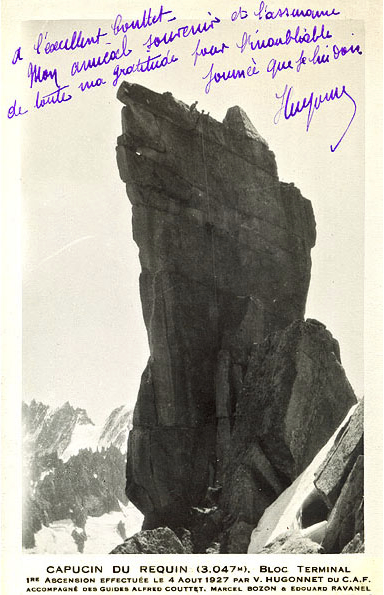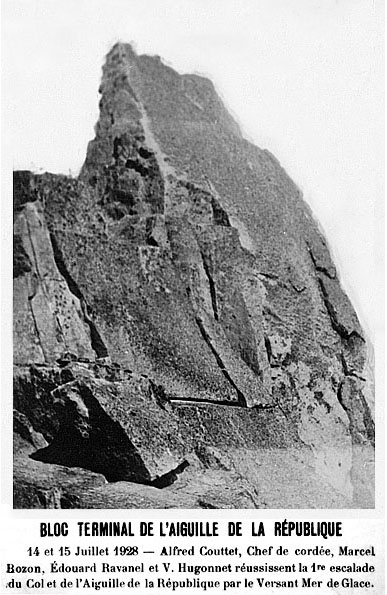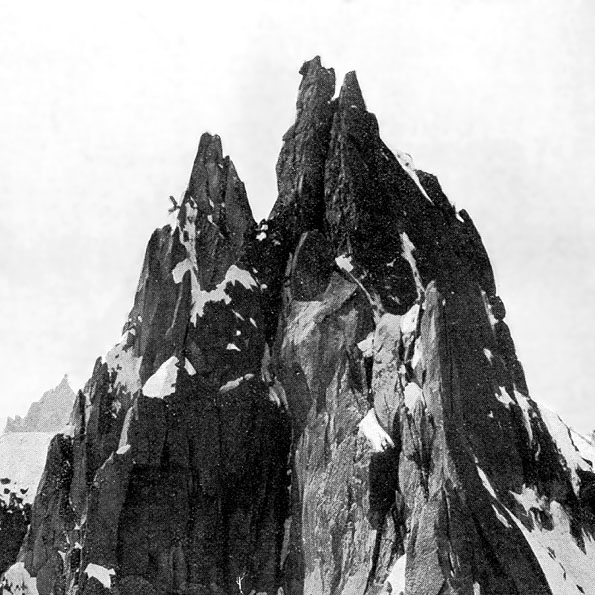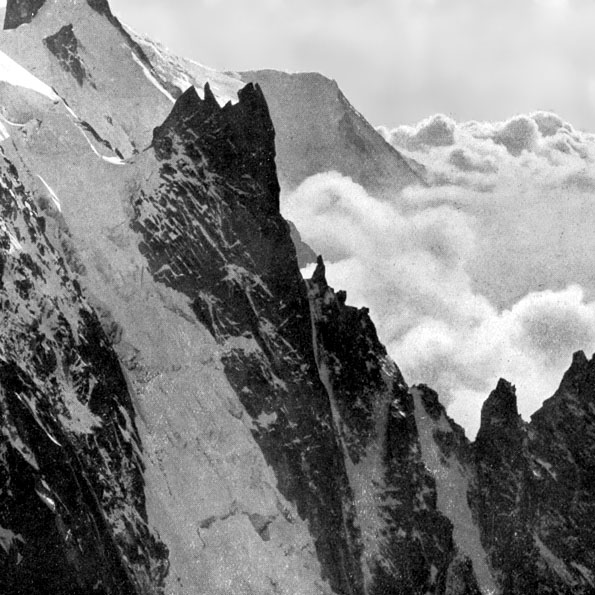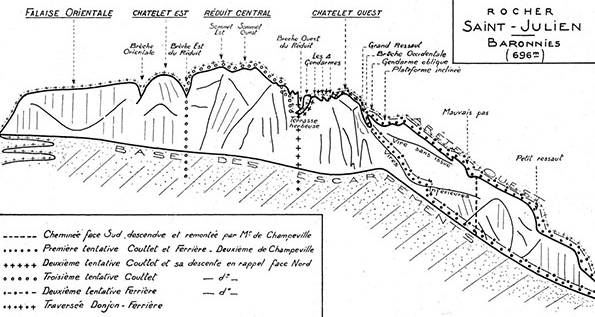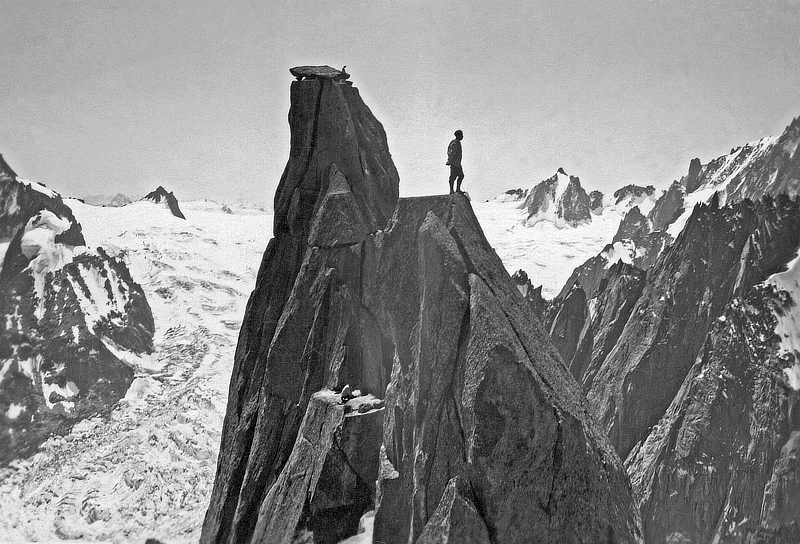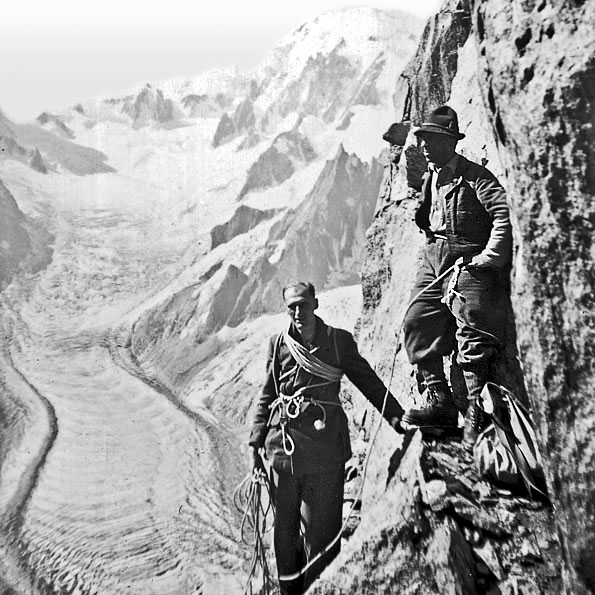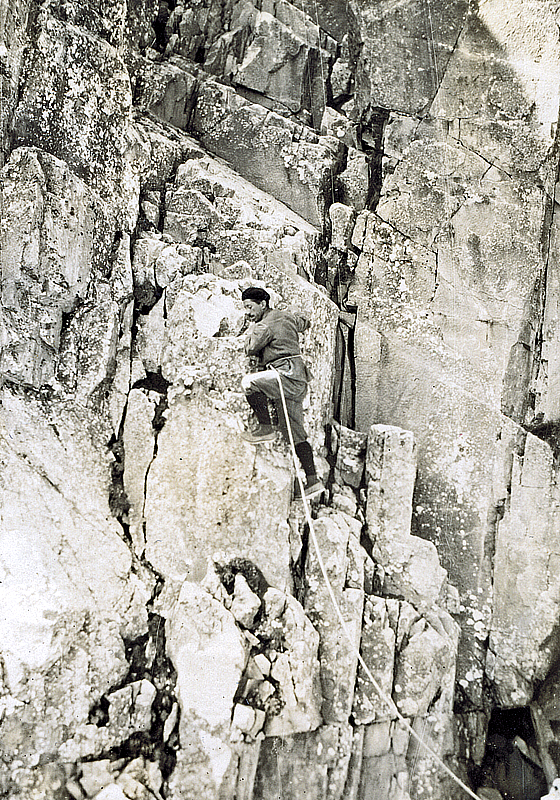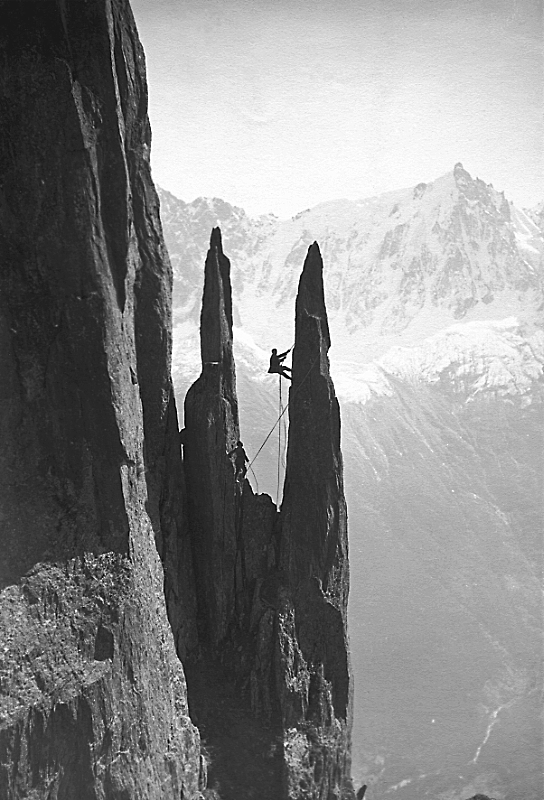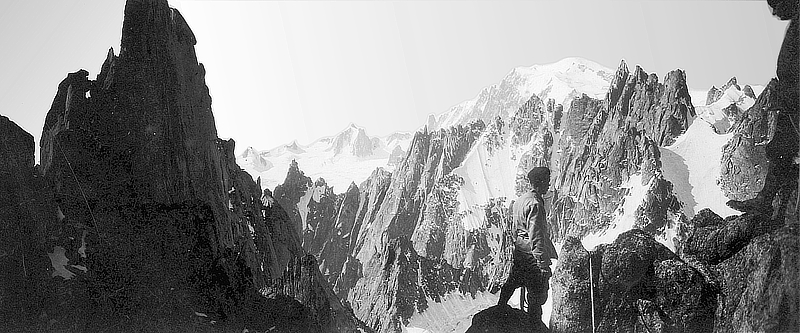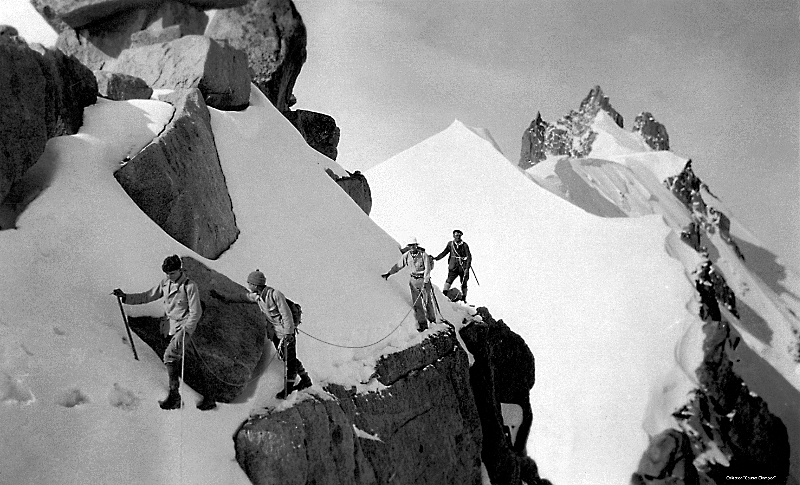Mont Blanc speed record holder for almost 60 years | more than 40 firsts to his credit
A born mountaineer!
It had been 4 years since he was last crowned French Champion. Ill and weakened, he returned from the war exhausted, unable to compete with the younger generation of skiers, particularly Kléber Balmat, the strong man of the moment.
COUTTET CHAMPION, the top-level skier, then embarked on a second career as a mountain guide. He was awarded the title of guide on 17 June 1920 and is listed as no. 1 in the 3rd register of guides. In the massif, he climbed more than forty first ascents or variants, always with his clients. It was out of the question for him to attempt climbs for the sake of glory. This is how the 1st complete crossing of the ridges at Rocher Saint-Julien in Buis-les-Baronnies escaped him after three aborted attempts due to the insufficient level or lack of stamina of his clients. And yet, according to Auguste Ferrière, the complete traverse of the ridges of Rocher Saint-Julien was at least his moral achievement.
But before embarking on this new career, Alfred COUTTET had to restore his health. For many months, he ate almost nothing but rice to restore his digestion, which had been damaged by years of front-line warfare in the muddy dampness of the trenches. During this long convalescence, he worked as a photographer on the glaciers of Chamonix, taking portraits of rich clients, princes and aristocrats from all over the world who had come to try their hand at mountain sports.
The fastest guide of the Chamonix valley
1910 • He joined the company as a porter and then as a guide, and soon became one of its most sought-after master climbers. One day, chance brought him into the presence of a Dutchman who, having climbed Mont Blanc in fifteen hours, was very proud of his achievement and claimed that no-one could do it faster than him.
— Not even a Chamoniard! asks COUTTET.
— Not even a Chamoniard.
The young guide immediately alerted two of his comrades, the Bouchards brothers, whom he knew to be vigorous and very hardy.
— Be there this evening, at 10 o'clock, in front of the town hall," he tells them. There's a record to beat.
At 10 o'clock they set off, lighting their way with a dim lantern. Without stopping, they crossed Les Tissours, Pierre-Pointue, the Bossons glacier and the Grand Plateau. At dawn, they reach the summit and set off again immediately. At 10 am. 45 in the morning, they were back in Chamonix, in front of the guides' office, where people were already gathering to congratulate them. And COUTTET, a little out of breath, says only.
— He was a braggart, that Dutchman.
Mont Blanc in less than thirteen hours. An astonishing record, considering that an ordinary caravan takes a day and a half to cover the same distance. So far, at least, no-one has attempted to take this record away from Alfred COUTTET.
[passage taken from "Les guides de nos montagnes : à la veillée, dans un refuge" by Géo-Ch. Véran | Le Miroir du Monde N°117 of 28th May 1932]
Before the Great War, when he achieved the Chamonix / Mont-Blanc summit / Chamonix record in just 13 hours, a record that would wait almost 60 years before being broken on 30 July 1968 by Jean-Marie Bourgeois and René Secrétant in 8h48 (Philippe Gaussot reported this event in October 1968 in the magazine Ski Français), he added to his list of achievements the reputation of being the fastest guide in the valley. This reputation followed him all the way to the Italian Dolomites, where the Italian guides had an expression of admiration for the Chamonix guide. When a climber made a brilliant run, that is to say with class and speed, from Cortina d'Ampezzo to Val Gardena, he was said to have made “a Couttet-style climb”.
1924 • Joseph DEMARCHI and Alfred COUTTET co-founded the Caisse de Secours en Montagne (Mountain Rescue Fund) to provide financial assistance to members of the Compagnie des Guides de Chamonix in the event of an accident.
1925 • 2 juillet • Alfred COUTTET and his namesake, Couttet from the Moussoux (guide), accompanied by Louis Vachette and the young Roger Frison-Roche made the first ascent of Doigt de l'Étala (2,830 m).
1927 •
- 4th August • With Victor Hugonnet and guides Marcel Bozon and Edouard Ravannel, he signed a first at the Capucin du Requin (3 047 m).
- 6th August • After three reconnaissance trips on 6, 13 and 29 August 1926 (the first with Miriam E. O'Brien, her brother Lincoln O'Brien and another guide, the second and third with Miss E. O'Brien and Vital Garny), Alfred COUTTET finally made the 1st ascent of the Aiguille de Roc (3 409 m) on the south-east side of the Grépon with Miriam E. O'Brien and Georges Cachat, who climbed in studded shoes, while Alfred COUTTET climbed in scarpetti (espadrilles).
[Source, account of the three attempts and the first by Miss E. O'Brien in the BULLETIN of the Appalachian Mountain Club - volume XXI N°10 - June 1928]
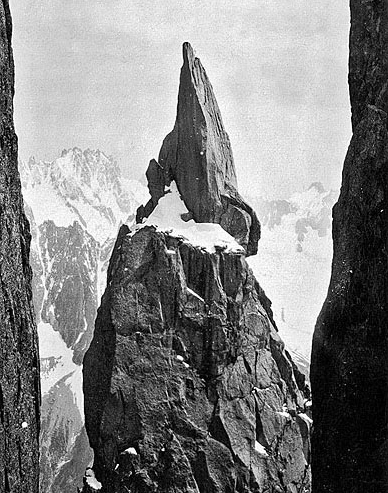
© copyright Couttet Champion family | all rights reserved | protected image
1928 •
- 14th & 15th July • With the same rope-mates as on the first ascent of Capucin du Requin, he made the first ascent of La Brèche (3,222 m) and of the Aiguille de la République (3 305 m) from the Mer de Glace side.
- 7th August • With his client Melle Paule Brunaud and Alfred Burnet, Alfred COUTTET signed the first ascent of the Requin ridge (2,851 m).
More than any other guide, this one (Alfred Couttet) has a taste for the difficult, the unachievable. Risk is an attraction for him, as long as it does not excessively compromise the safety of those accompanying him. He is the only person to have attempted several climbs that no one has done since.
One of them, and the hardest, was that of an as yet unnamed point, shown on the map at an altitude of 2,851 metres, at the foot of the Requin needle. It is an isolated granite candle, protected by long, frighteningly smooth walls, almost overhanging the glacier.
— Will we go up there?" asked COUTTET to a young and very experienced mountaineer, Mlle Brunot.
— Tomorrow if you want.
A good mountaineer, Alfred Burnet, was chosen as porter, and shortly after 4am the caravan left the Requin refuge. By 7 o'clock, the three climbers were hard at work. For a long time, COUTTET interrogated the rock, looking for its passage, exploring the smallest cracks. At 3 o'clock in the afternoon, he had to admit defeat... temporarily.
Very early the next day, he was back at 'his' needle, untying and rolling the ropes he had brought with him. At 4 o'clock in the evening, he reached the summit: it had taken him nearly eight hours to climb the 60 metres, after three successive 'throws' of the rope.
— I would be astonished," admitted Alfred COUTTET when asked about these two memorable days, "if Point 2.851, whose tranquillity was threatened for a moment, received any more visits. It takes so much patience and such a determination to reach the top, for a purely acrobatic result, that it probably won't be done again for a long time.
[passage taken from "Les guides de nos montagnes : à la veillée, dans un refuge" by Géo-Ch. Véran | Le Miroir du Monde N°117 of 28th May 1932]
First ascent of the Aiguille Verte via the north face
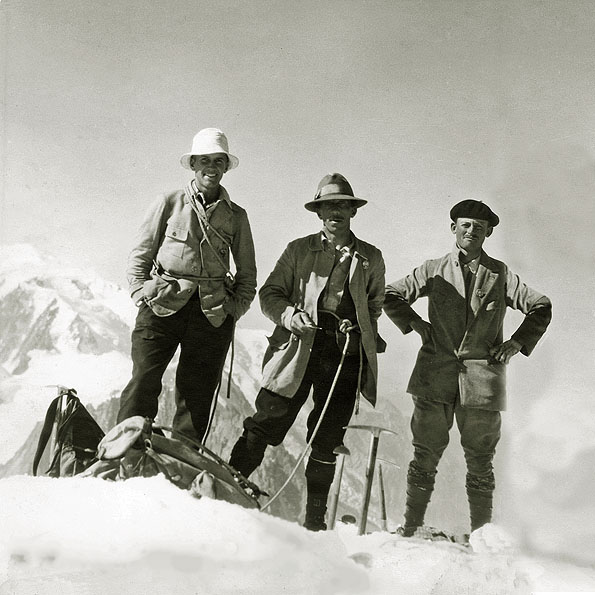
From left to right: Bradford Washburn, Alfred Couttet and Georges Charlet ;
and behind the lens, André Devouassoux.
© copyright Couttet Champion family | tous droits réservés | image protégée
1929 •
- 2nd September • First ascent of the North Face of La Verte with Bradford Washburn, Georges Charlet (Armand Charlet's brother) and André Devouassoux (porter).
- 12th September • Alfred COUTTET, Paul Leroy-Edwards and André Clérico made the first of the Dent du Crocodile (3 640 m).
- 12th September • according to the addendum to the Guide Vallot , Alfred COUTTET, André Clerico, J. W. Alexander and an anonymous climber made the first ascent of the northern tip of the Aiguille des Deux Aigles (3 487m). According to Robert Gréloz, the first ascent was made by H. Beaujard in 1905, 24 years earlier. But Beaujard used a crossbow to throw a rope to the summit and finish the ascent using the rope to pull himself up. According to Robert Gréloz:
"Alfred COUTTET made this ascent more elegantly than his predecessors. He did put a rope across the summit, and only by his own efforts, but it only served to allow him to dangle and reach an ascending tendril that runs along the Pélerins side. This led to a crack that split the last part of the monolith, enabling him to reach the summit. According to Alfred COUTTET, this was one of the most exposed and tricky passages he had ever encountered."
1930 •
- 12th August • The De Lepiney brothers had forced their way through the famous fissure on the North West face of the Peigne, but to complete the ascent they had to call on outside help: Alfred COUTTET. He tackled the last overhang and succeeded by free climbing!
- 31st August / 1st September • Alfred COUTTET, Miss Geraldine I Fitz-Gerald and Anatole Bozon make the 1st complete crossing of the Grandes Jorasses without a bivouac in 22h20, from the Col des Jorasses to the Col des Hirondelles (3 456m).
Miss Géraldine Fitz-Gerald and her guides Alfred Couttet and Anatole Bozon have just achieved a sensational feat, just after the second ascent of the Aiguille de la République.
Setting off from the Leschaux refuge (at around 2,400 metres) at 3 h. 10 a.m. on 31 August, the caravan reached the Col des Grandes Jorasses (3,825 metres) at 7.15 a.m., having had enough trouble getting over the last steep slopes, all of which were made of live ice. Leaving the Col at 7.30am, the climbers climbed the difficult, glassy rocks that led them to Pointe Young. This was the toughest part of the route. By 9.30am, Pointe Young had been climbed and the caravan continued on to Pointe Helena (4,045 metres) and finally Pointe Whymper (4,196 metres). Using the rope and gaining the deep gap that separates the two main summits of the Grandes Jorasses, at 14 h. 30, the highest peak, Pointe Walker, was reached (4,208 metres).
From Pointe Walker, the ridge descends steadily eastwards to the Col des Hirondelles (3,456 metres), a difference in altitude of 800 metres.
Initially easy, the descent of the ridge soon became glassy and, on several occasions, the abseiling rope had to be used. The passage of the Brèche en V, a rocky spur that stopped attempts to climb this ridge for a long time, was completed in a single abseil from a height of 35 metres. Alfred Couttet found the pitons placed by guide Rey, who made the first ascent. At 19 h. 40, the Col des Hirondelles had been reached. Night had fallen, but Alfred Couttet, keen to spare Miss Fitz-Gerald the rigours of a bivouac at such an altitude, did not hesitate to descend the escarpments of the Col, which were completely unknown to him, at night. At 1 am. 30 on 1 September, the three brave climbers reached the Leschaux refuge. The first complete crossing of the Grandes Jorasses without a bivouac had been completed in less than 22 hours 30 minutes.
[Article taken from the daily newspaper "Figaro" No. 249 of 6th September 1930]
- 5th September • To come down from the Col du Fou (3 365m), Alfred COUTTET, André Clerico, J. W. Alexander and a friend made the first attempt to reach and then climb the Glacier suspendu de Blaitière. At the time, few climbers were talented enough to free-climb the particularly difficult summit block of the Aiguille du Fou (3,501m) using the small holds on this granite monolith, i.e. without using a rope. Along with Armand Charlet, who was the first to achieve this feat in the summer of 1926, only Jean Grobet, Hugues Paillon, M. Pojet and Alfred COUTTET have ever achieved this feat.
The best climber of his generation
1931 •
- 24th July • First complete traverse of the North West ridge of the Aiguille du Peigne by Alfred COUTTET, Melle Paule Brunaud, and André Clérico.
- 26th July • Alfred COUTTET, Roger Valluet and Henri Comte achieve the feat of climbing the Aiguille des 2 Aigles from Chamonix in a single day.
That same year, the same team set another speed record, climbing the North Face of the Aiguille de Bionnassay in 4h30! In 1963, at the age of 74, Alfred COUTTET, still "the right foot, the right eye", did this climb again!
1933 • 7th May • It all began a year earlier at the Rocher Saint-Julien (696m) at Buis-les-Baronnies (Drôme) :
"COUTTET enters the scene. On 22 March 1932, an American, Paul Leroy-Edwards, accompanied by Alfred COUTTET, a Chamonix guide, climbed the West ridge and reached the Brèche Occidentale, but had to give up at the base of the Grand Ressaut and descend via a series of ledges below and along the West ridge on the North face of the mountain.
Piqued by his client's failure, COUTTET returned the following year, accompanied by Antonin and Jean Rozier, members of the Lyon section of the Club Alpin Français, and the Chamonix porter Demarchi.
On 7th May, the caravan climbed back up the West ridge, forcing the Grand Ressaut and reaching the summit of Châtelet Ouest, where it left a record of its ascent in a bottle. This time, however, COUTTET was disappointed, as lack of time meant that the caravan had to abandon the traverse of the ridges in their entirety and descend the Brèche Ouest du Réduit by successive abseils. But COUTTET was not to be deterred.
[Auguste Ferrière - Revue Alpine section Lyonnaise du CAF N°349 - 1946]
1934 • 18th April • In the spring, he returned to the assault, accompanied by Mme Marti. Taking up the route they had already climbed twice, the team removed the obstacles mentioned above, opened a route on the West face of the Réduit Central and reached the highest point of the traverse, a first in the world.
But it seems that the two climbers were thwarted by compelling circumstances, because two thirds of the way up, they gave up and made several abseils down the Brèche Ouest du Réduit. Tired of this series of failures for which he was not responsible, COUTTET did not return to the Saint-Julien and it was a pity; the "first" of the complete traverse of the ridges eluded him from that moment on, although morally he had well deserved it."
[Auguste Ferrière - Revue Alpine section Lyonnaise du CAF N°349 - 1946]
1937 • First ascent of the Pierra-Menta North Ridge in the Beaufortin massif.
Other firsts include:
- Arête Nord-Est of the Grands-Charmoz en 1929 (3 445 m)
- Ascent of the northern summit of the Aiguille des Ciseaux (3,479 m). The summit was renamed Pointe Alfred COUTTET in his honour at the request of his clients, Ms Van Hœserlande and Mr Geoffray, with whom he made the ascent.
- North face Grépon/Mer de Glace with Jean Mermillod
- Corne de Chamois…
With a large and prestigious international clientele, Bradford Washburn (Harvard graduate, founder of the Boston Science Museum, recipient of the Centennial Award of the National Geographic Society,…), Albert Szent-Györgyi from Segez in Autriche (Nobel Prize in Medicine 1937), he has travelled the length and breadth of Europe's mountains. Invited to Norway, called to Poland in the Tatras, to Slovakia in the Beskids, to the Carpathians in Romania, requested in Spain, asked for in the Tyrol, he has left his mark on many of the peaks and scrapes of our old Europe. Let's not even mention the Alps, which he knew inside out, summer and winter alike, as he was also one of the promoters of long-distance ski touring and ski mountaineering. He climbed the Spanish Sierras and, still attracted by pure climbing, discovered a number of small French climbs such as the Dentelles de Montmirail.
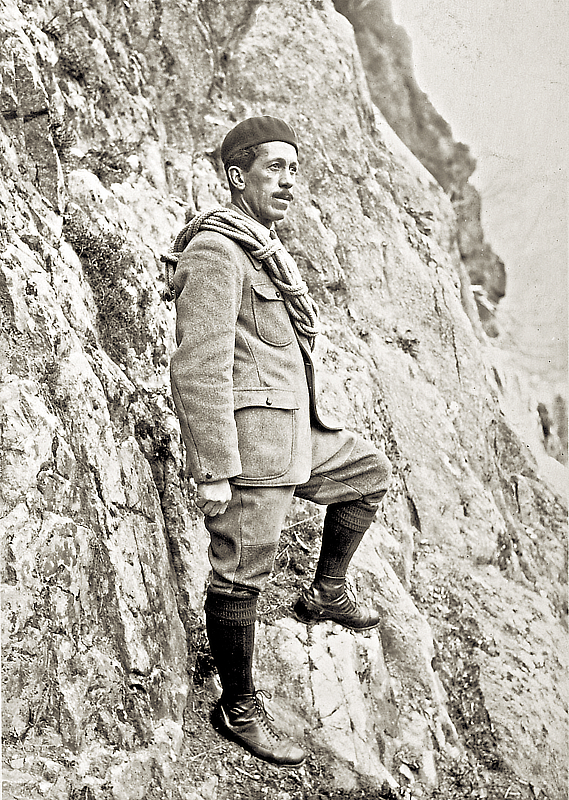
© copyright Couttet Champion family | tous droits réservés | image protégée
Today, from archives and personal accounts, I have the satisfaction of knowing that my Champion grandfather was, according to competent opinion, an extraordinary man and the best climber of his generation!
Chamonix to the summit of Mont Blanc and back
The record through time
- | 20th July 1864 | Frédérick Morschead | 16h00
- | 21st August 1910 | Alfred Couttet, Joseph and Marcel Bouchard | 12h45 approved at less than 12h00
because of the rescue of a man while the record was being set. The rescue lasted one hour. - | 31st July 1968 | René Secrétant and Jean-Marie Bourgeois | 8h48
- | 20th July 1970 | René Arpin and Paul Chassagne | 7h58 unregistered record
- | 30th July 1975 | Louis Bailly-Bazin | 8h10
- | 27th July 1986 | Thierry Gazan and Pierre Cusin | 7h56
- | 5th August 1987 | Laurent Smagghe | 6h47
- | 13rd July 1988 | Pierre Lestas | 6h22
- | 26th July 1988 | Laurent Smagghe | 6h15
- | 28th July 1988 | Jacques Berlie and Pierre Cusin | 5h37
- | 5th August 1988 | Laurent Smagghe | 5h29
- | 21st July 1990 | Pierre-André Gobet | 5h10
- | 11th July 2013 | Kilian Jornet | 4h57
